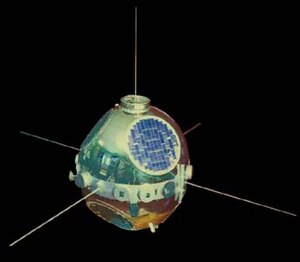Solrad 8
| Solrad 8 | |
|---|---|

|
|
| Country: |
|
| Operator: |
|
| Mission dates | |
| Dimensions: | 57 kg |
| Begin: | November 19, 1965 |
| Starting place: | Wallops LA-3 |
| Launcher: | Scout-X4 |
| Flight duration: | 1 year, 9 months |
| Status: | burned up (end of mission in August 1967) |
| Orbit data | |
| Rotation time : | 100 min |
| Orbit inclination : | 59.7 ° |
| Apogee height : | 891 km |
| Perigee height : | 704 km |
| Eccentricity : | 0.01302 |
Solrad 8 (also known as SE-A , and Explorer 30 ) was one of the satellites of SOLRAD program ( english solar radiation : solar radiation ), which in 1960 began with the radiation of the sun by using photometers continuously recorded. The spin axis of the spin-stabilized satellite was aligned perpendicular to the line between the sun and the satellite, so that the 14 radially arranged X-ray and ultraviolet photometers could always observe the sun despite the satellite's own rotation. The data collected was fromTelemetry system of the satellite transmitted in real time to the stations of the STADAN network on earth.
The satellite observed the solar eclipse on May 20, 1966, possibly the first observation of an eclipse by an artificial satellite.
The satellite fulfilled its tasks as expected, with the exception of the spin system, which was supposed to maintain a rotation speed of 60 / min, since a too slow rotation (less than 10 / min) would have made data analysis more difficult. The rotation speed gradually decreased until it was only 4 / min on September 12, 1966. At this point, the ground control was able to increase again to 78 / min, which, however, exhausted the remaining fuel reserves. From then on, the speed of rotation slowed down again and reached the critical value of 10 / min in August 1967.
Web links
- Solrad Satellites (8, 9 and 10) ( Memento from March 29, 2016 in the Internet Archive )
- Solrad 8 in the NSSDCA Master Catalog (English)
Individual evidence
- ^ Solar observing satellites . Rammb.cira.colostate.edu. Retrieved May 27, 2014.
- ↑ Solrad . Designation-systems.net. Retrieved May 27, 2014.
- ↑ a b M. Landini, D. Russo, GL Tagliaferri: Solar Eclipse of May 20, 1966, observed by the Solrad 8 Satellite in X-ray and Ultra-violet Bands. In: Nature. 211, 1966, pp. 393-394, doi : 10.1038 / 211393a0 .
- ↑ SOLRAD 8 . Space archeology. Retrieved May 27, 2014.
- ^ National Research Council (US). Space Science Board, COSPAR: United States Space Science Program: Report to COSPAR. . National Academies, 1967, p. 47.
- ↑ NASA: SP-4312 Dreams, Hopes, Realities-Chapter 1: Goddard's First Forty: The Quest to Learn . History.nasa.gov. October 4, 1957. Retrieved May 27, 2014.

